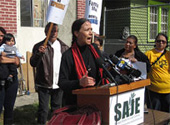 There’s a house on East Adams Boulevard in South Central Los Angeles where broken windows are covered by cardboard and wrapping paper. Cockroaches crawl in water glasses and a ratty extension cord connecting a generator to a bare fluorescent bulb is stapled to the ceiling.
There’s a house on East Adams Boulevard in South Central Los Angeles where broken windows are covered by cardboard and wrapping paper. Cockroaches crawl in water glasses and a ratty extension cord connecting a generator to a bare fluorescent bulb is stapled to the ceiling.
This house is in foreclosure under Fannie Mae. It’s also home to three families – 17 people total, including 11 children.
“There’s little baby cockroaches crawling in that cupboard. You want to take a souvenir?” Haide Clemente laughed. She’s a stay-at-home mother in this house. Her husband works in a factory, making parts for cars and airplanes.
One of the families had been there for nine years when foreclosure proceedings started last spring. The family says Fannie Mae stopped telling them where to send their rent checks and the lender still hasn’t answered their calls. In September, they stopped paying rent. Their electricity was cut off.
Strategic Action for a Just Economy, or SAJE, opened the house to public visits on Thursday. Executive Director Paulina Gonzalez says there are many Fannie Mae homes like it.
“They have dozens of properties in South Los Angeles, in Southeast Los Angeles, that are in foreclosure. They’re preparing to sell their properties and become equity owners, and we’re here to ask Fannie Mae, is Fannie Mae going to be Los Angeles’s newest slumlord?”
On Monday Fannie Mae announced a plan to let one investors buy whole chunks of houses in cities hit hardest by the mortgage crisis, including about 600 properties in Los Angeles and Riverside.
In California, and maybe nationwide, the Federal Housing Finance Agency will chose one new owner after a rigorous application process.
But Nancy Ibrahim, Executive Director of Esperanza Community Housing Corporation, says tenants also need to know their rights.
“A lot of people tragically end up in a situation like this not only because of Fannie Mae but because of many, many other banks, and they disappear so quickly that we can’t even inform them of their tenant rights.”
For example, SAJE says Clemente’s family accepted two thousand dollars from a “Cash for Keys” program to help cover their moving costs. They could have gotten nine times as much help through government programs. They just didn’t know about them. And Fannie Mae isn’t responsible for that.
Fannie Mae could not be reached for comment by the time of our broadcast.














